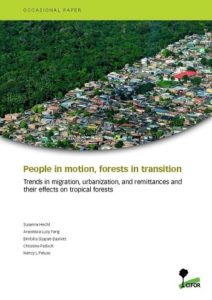
Inclusive development is on the agenda at the World Economic Forum Annual Meeting, kicking off this week in Davos, Switzerland. We sat down with Christine Padoch, former Director of CIFOR’s Forests and Human Wellbeing Team, to discuss how inequality relates to global migration patterns, and what it all means for forests.
DO YOU SEE A LINK BETWEEN GLOBAL DISPARITIES AND MIGRATION PATTERNS?
I think that when we talk about disparity, what most people are talking about is income disparity. But the disparities between rural areas and urban areas in services, like education, healthcare and so on, are enormous in many of the countries that we work in. The difference in the education that Dayak farmers’ kids in Kalimantan villages get, versus what the middle class kids in Jakarta get is like night and day. So it’s not just income disparities we need to understand, but also disparities in services. And that, obviously, pushes migration.
What I’ve done in my own research on migration in the Peruvian Amazon, is to interview people on why they went to the city in the first place. It’s very often not because they expected to get a better job, but because they needed to go for education, for healthcare – just to really feel that they’re integrated into regional or national society. Communications networks still don’t reach many of these remote Amazonian areas.
I think it’s very often those kinds of disparities that are really pushing migration within countries. And international migration is driven by that and by income disparities as well. So I think that growing inequality in many places certainly drives a lot of mobility. And how migration interacts with forests is a complex issue, as we know.
WHAT ARE THE IMPACTS FOR FOREST-DEPENDENT COMMUNITIES?
For forest-dependent people, we first need to understand that their incomes tend to be sourced in very complex ways, and that actually has been the case for a long time. Remittances are one of those sources for many people.

Migrants tend to send home personal remittances. With the scale of migration that we are seeing today, remittances, both international and internal, have become enormous flows of income, and they’re very important for many forest-dependent households today. I think in places like Indonesia, for example, we’ve misunderstood — and certainly, we’ve underestimated — how important this has been for a long time.
Remittances are very interesting because they go directly to households, unlike development aid, which goes through government agencies, and before it reaches households is encumbered by a large number of requirements and processes. Whereas personal remittances are important because they come in directly and households really can determine how they want to use them, and often the actual remittance flows are far, far larger than development aid.

WHAT ARE THE IMPACTS FOR FORESTS?
Whenever foresters have talked about migration and forests before, they have considered it a negative, often summarized by simplistic statements like “migrants cut forests”. But the truth is that if we look closely, we see that there is a lot of migration not just into forests, but also out of forests, and how that affects forests is something that has been given less attention by researchers. So our projects are looking at, for instance, how much income comes in from migration flows by those who leave forests, how households and communities are investing that income, and how that affects forest use.
We have indications that in some places, migration ultimately results in more forest cover not less, because people choose to buy more food from the market rather than clear forest to plant their own, and because they no longer have the labor force to cut trees. So fewer trees are cut and forests may recover. But on the other hand, we have also seen that remittances may be invested in chainsaws and hired labor to cut more trees, so as I said, it’s a complex issue. We are trying to identify the factors that lead to different outcomes for communities and for forests.
There are many, many different pathways by which migration affects forest users and could potentially affect forest use. What the outcomes are depends on other variables in communities, and certainly inequality is one of these. We hope to understand enough about migration and forests to ultimately help promote policies that result in less pronounced disparities, as well as better forest management.











